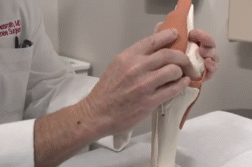CHICAGO, Ill. (Ivanhoe Newswire)—According to the Agency for Healthcare Research and Quality, nearly 800,000 knee replacements are performed each year in the United States … And the American Academy of Orthopedic Surgeons estimates that will increase by a staggering 180 percent by 2030. Now, a new robotic surgery that is getting patients back, what doctors call “optimal function.”
Seventy-five-year-old Susan Cusack is a champion on the pickleball court, but one day in 2018 …
“The ball came across the net, it was a very low shot, I went to go return it and I heard a very loud crunch in my right knee,” Susan Cusack recalled.
Her arthritic knee had given out and needed to be replaced.
“When I went back to pickleball about eight or nine weeks after surgery, I could jump, I could run on the courts,” Cusack described.
But then just two years later, Susan dove for another a low shot and …
“This time the loud crunch was in my left knee. So, I though ‘hm, this is familiar to me,’” Cusack shared.
This time, Dr. Henry Finn offered Susan a new approach. It puts robotic technology in the palm of his hand.
“We believe that by using this device, there is improved sizing and placement of the components, which is more accurate than traditional techniques,” explained Finn, the Medical Director at Chicago Center for Orthopedics & Robotic-Assisted Surgery.
Dr. Finn used the CORI surgical system, or Core of Real Intelligence.
“The computer directs a handheld cutting tool that is used to accurately remove and shape the ends of the bones during the knee replacement surgery,” illustrated Dr. Finn.
Resulting in better balance and stability, meaning Susan can dominate on the courts for many years to come.
“I just want to be able to do, selfishly, whatever I want to do!” Susan exclaimed.
In addition to a smaller incision, less bleeding, and less time on the surgical table, patients who undergo knee replacement with the CORI surgical system also have a faster recovery. Susan was able to go home the day right after her surgery.
Contributors to this news report include: Cyndy McGrath, Executive Producer; Sabrina Broadbent, Field Producer; Roque Correa, Editor.
To receive a free weekly e-mail on Medical Breakthroughs from Ivanhoe, sign up at: http://www.ivanhoe.com/ftk
Sources:
https://www.chicagoorthorobotics.com/patient-stories/susan-cusack-s-patient-story/
MEDICAL BREAKTHROUGHS
RESEARCH SUMMARY
TOPIC: CORI: NEW TYPE OF ROBOTIC SURGERY GIVES SUSAN A BETTER KNEE!
REPORT: MB #4909
BACKGROUND: Osteoarthritis is the most common form of arthritis, affecting millions of people worldwide. Osteoarthritis occurs when the protective cartilage that cushions the ends of your bones wears down over time. This can also be called bone on bone arthritis. Although osteoarthritis can damage any joint, the disorder most commonly affects joints in your hands, knees, hips and spine. While symptoms can usually be managed, the damage to joints cannot be reversed. Doctors recommend staying active, and maintaining a healthy weight to decrease risk. Some treatments might slow progression of the disease and help improve pain and joint function. Osteoarthritis symptoms are progressive and often develop slowly and worsen over time. Signs and symptoms of osteoarthritis include pain, stiffness. tenderness, loss of flexibility, a grating sensation, bone spurs and swelling.
(Source: https://www.mayoclinic.org/diseases-conditions/osteoarthritis/symptoms-causes/syc-20351925)
TRADITIONAL TREATMENT: Total or partial knee replacement surgery is a treatment for pain and or disability in the knee. A knee replacement, also called knee arthroplasty, might be more accurately termed a knee “resurfacing” because only the surface of the bones are replaced. There are four basic steps to a knee replacement procedure, the first is to prepare the bone. The damaged cartilage surfaces at the ends of the femur and tibia are removed along with a small amount of underlying bone. Next, a surgeon positions the metal implants. The removed cartilage and bone is replaced with metal components that recreate the surface of the joint. These metal parts may be cemented or “press-fit” into the bone. Next, the patella is resurfaced. The undersurface of the patella (kneecap) is cut and resurfaced with a plastic button. Some surgeons do not resurface the patella, depending upon the case. Finally, surgeons will insert a spacer. A medical-grade plastic spacer is inserted between the metal components to create a smooth gliding surface.
(Source: https://orthoinfo.aaos.org/en/treatment/total-knee-replacement)
NEW TECHNOLOGY: Henry Finn MD, medical director of the Chicago Center for Orthopedics & Robotic-Assisted Surgery has performed the first hand-held robotics-assisted total knee replacement in Illinois using the CORI Surgical System. CORI stands for Core of Real Intelligence. It is one of the most advanced and efficient hand-held robotic technologies for knee replacement in the world. Instead of requiring a CT scan or an MRI prior to surgery as with first generation robotic systems, it allows surgeons to create a customized 3D digital model of each patient’s knee for each surgery. The model is used to determine where the implant should be placed based on the patient’s own unique anatomy, providing optimal placement and function of the implant, and creating a faster recovery.
(Source: https://www.chicagoorthorobotics.com/patient-stories/susan-cusack-s-patient-story/)
FOR MORE INFORMATION ON THIS REPORT, PLEASE CONTACT:
MARYANN FIORENTINO,
(773) 564-5880
If this story or any other Ivanhoe story has impacted your life or prompted you or someone you know to seek or change treatments, please let us know by contacting Marjorie Bekaert Thomas at mthomas@ivanhoe.com



